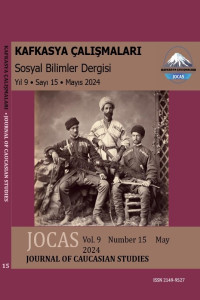Review of Empire of Refugees: North Caucasian Muslims and the Late Ottoman State by Vladimir Hamed-Troyansky [Vladimir Hamed-Troyansky'nin Mülteciler İmparatorluğu: Kuzey Kafkasyalı Müslümanlar ve Geç Dönem Osmanlı Devleti Kitabı Değerlendirmesi]
Öz
Mülteciler İmparatorluğu: Kuzey Kafkasyalı Müslümanlar ve Geç Dönem Osmanlı Devleti adlı eserinde Vladimir Hamed-Troyansky, dilbilimsel, tarihyazımı ve araştırma becerilerini kullanarak, Kuzey Kafkasya'dan Osmanlı İmparatorluğu topraklarına yapılan mülteci hareketlerine ilişkin son derece karmaşık bir bulmacaya odaklanıyor. Büyük imparatorluklar üçlüsünün (Kafkasya, Çarlık Rusya'sı ve Osmanlı İmparatorluğu) birbiri tarafından anlaşılmayan dillerinde yazılmış birincil kaynak materyallerin titiz bir şekilde yorumlanması ve ustalıkla analiz edilmesiyle ortaya çıkan bu monografi, on dokuzuncu yüzyıl ve yirminci yüzyılın başlarında Kafkasya bölgesinde yaşanan göç ve yerinden edilmenin iç içe geçmiş tarihini anlamamızda şimdiden değişimlere yol açan çığır açıcı bir araştırmanın çarpıcı bir örneği olarak karşımıza çıkıyor.
Anahtar Kelimeler
Review of Empire of Refugees: North Caucasian Muslims and the Late Ottoman State by Vladimir Hamed-Troyansky [Vladimir Hamed-Troyansky'nin Mülteciler İmparatorluğu: Kuzey Kafkasyalı Müslümanlar ve Geç Dönem Osmanlı Devleti Kitabı Değerlendirmesi]
Öz
In his seminal work, Empire of Refugees: North Caucasian Muslims and the Late Ottoman State, Vladimir Hamed-Troyansky utilizes his formidable linguistic, historiographic, and research skills to bring into focus an exceptionally complex puzzle of transimperial movement of refugees from the North Caucasus into the lands of the Ottoman Empire. Through meticulous interpretation and deft analysis of primary source materials written in the mutually unintelligible languages of the great imperial triad: the Caucasus, tsarist Russia, and the Ottoman Empire, this monograph emerges as a striking example of groundbreaking scholarship, which has already prompted shifts in our understanding of the entangled history of migration and displacement in the Caucasus region during the nineteenth and early twentieth centuries.
Anahtar Kelimeler
Review of Empire of Refugees: North Caucasian Muslims and the Late Ottoman State by Vladimir Hamed-Troyansky [Vladimir Hamed-Troyansky'nin Mülteciler İmparatorluğu: Kuzey Kafkasyalı Müslümanlar ve Geç Dönem Osmanlı Devleti Kitabı Değerlendirmesi]
Öz
In his seminal work, Empire of Refugees: North Caucasian Muslims and the Late Ottoman State, Vladimir Hamed-Troyansky utilizes his formidable linguistic, historiographic, and research skills to bring into focus an exceptionally complex puzzle of transimperial movement of refugees from the North Caucasus into the lands of the Ottoman Empire. Through meticulous interpretation and deft analysis of primary source materials written in the mutually unintelligible languages of the great imperial triad: the Caucasus, tsarist Russia, and the Ottoman Empire, this monograph emerges as a striking example of groundbreaking scholarship, which has already prompted shifts in our understanding of the entangled history of migration and displacement in the Caucasus region during the nineteenth and early twentieth centuries.
Anahtar Kelimeler
Ayrıntılar
| Birincil Dil | İngilizce |
|---|---|
| Konular | Kırsal ve Bölgesel Coğrafya, Tarihi Coğrafya, Göç, Nüfus Eğilimleri ve Politikaları |
| Bölüm | Kitap Değerlendirmesi |
| Yazarlar | |
| Yayımlanma Tarihi | 31 Mayıs 2024 |
| Gönderilme Tarihi | 31 Mayıs 2024 |
| Kabul Tarihi | 31 Mayıs 2024 |
| Yayımlandığı Sayı | Yıl 2024 Cilt: 9 Sayı: 15 |


